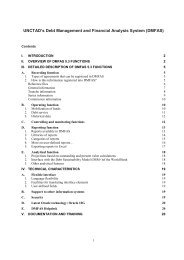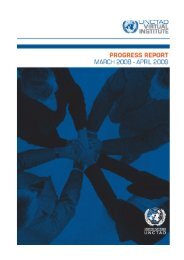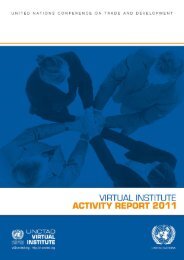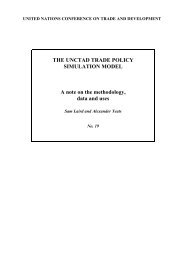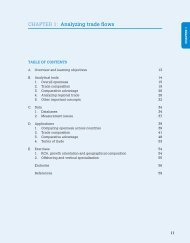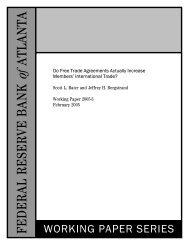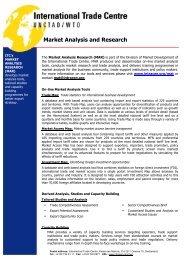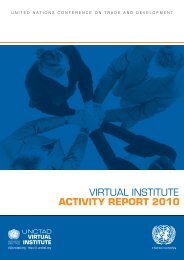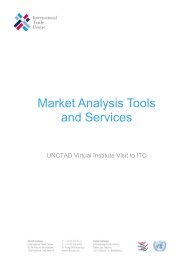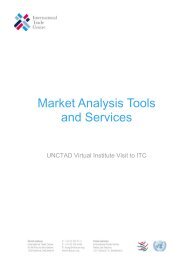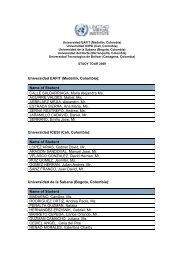Investment Policy Review - Rwanda - UNCTAD Virtual Institute
Investment Policy Review - Rwanda - UNCTAD Virtual Institute
Investment Policy Review - Rwanda - UNCTAD Virtual Institute
You also want an ePaper? Increase the reach of your titles
YUMPU automatically turns print PDFs into web optimized ePapers that Google loves.
<strong>Investment</strong> <strong>Policy</strong> <strong>Review</strong> of <strong>Rwanda</strong><br />
The success of this industry in neighbouring Kenya, and to a lesser extent in Uganda, in exporting to<br />
Europe points to what can be achieved. Indeed, the horticulture and floriculture industry in sub-Saharan<br />
Africa as a whole has now overtaken the traditional exports of coffee and cocoa. The <strong>Rwanda</strong>n industry<br />
is clearly in its infancy: apart from the notable pioneering effort of <strong>Rwanda</strong> Flora (chapter I, box I.2), these<br />
significant changes in African agriculture have not reached <strong>Rwanda</strong> yet. The disruptions caused by the<br />
genocide may be partly responsible as the take-off of this industry in Africa occurred in the 1990s. Yet,<br />
the success stories in neighbouring countries show that an industry can develop quickly from humble<br />
beginnings and that business leadership can resolve many issues such as transport logistics, adherence to<br />
sanitary and phytosanitary standards and smallholder support, some of which have traditionally been the<br />
preserve of governments (box III.3).<br />
Box III.3. FDI and horticulture and floriculture in Kenya<br />
Kenya’s success in providing high-quality products at competitive costs and in fulfilling strict sanitary<br />
and phytosanitary standards (SPS) is the result of private investment and initiative, as the flower, vegetables<br />
and fruit sectors have been subject to relatively little government intervention through extension services<br />
to farmers or public marketing boards. Exports by these three sectors have consistently increased as a share<br />
of total exports over the past decades, growing to an aggregate of close to 23 per cent in 2003, equivalent<br />
to $550 million, from less than 6 per cent in 1980.<br />
Horticulture and floriculture were initially launched by small investors (e.g. Homegrown) with very<br />
little capital. A number of the initial investors have grown considerably, however, and large firms currently<br />
dominate the sector, with 24 industrial operators accounting for 72 per cent of total export volume. The<br />
dominance of large firms is not due to capital intensity, however, but results from the need to meet the<br />
demanding standards of buyers for food safety, traceability, environmental impact and labour standards.<br />
Indeed, flower, vegetable and fruit production are very labour-intensive, and cut flowers alone employ 40-<br />
50 000 people directly and another 60-70 000 indirectly. While the distribution side of the three sectors is<br />
dominated by foreign investors, linkages with the domestic agricultural sector are sizeable – particularly in<br />
the flower and vegetables sectors – as locally-owned outgrowers frequently take part in production.<br />
Two key areas of technological competence are essential in distributing and selling products to the<br />
EU and US markets. The first is to ensure adequate traceability and environmental standards. While this is<br />
widely recognized to act as a disincentive to small-scale producers, some of the largest (foreign-owned)<br />
exporters use small-scale outgrowers, and provide them with the extension services they need to sustain<br />
their market position.<br />
The second key area of technological competence lies in the control of logistics. Kenyan growers<br />
and packers add value to fresh vegetables by undertaking the full range of pack-house activities, including<br />
washing, packing and labelling the produce with store-specific packaging and labelling. Their control over<br />
logistics and production allow their European customers to change their purchase requirements up to the<br />
middle of the day of dispatch in large airplanes flying to Europe every night. Similarly, logistics in the flower<br />
sector enable the full cold-chain storage of flowers immediately after picking, which allows supermarkets to<br />
guarantee their produce for one week after sale from the store.<br />
Source: <strong>Investment</strong> <strong>Policy</strong> <strong>Review</strong>, Kenya, <strong>UNCTAD</strong> (2005).<br />
102



